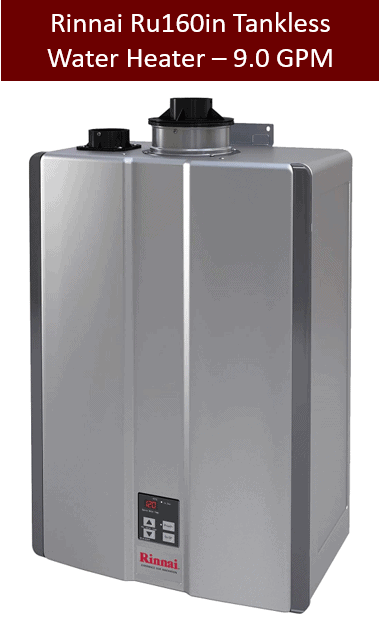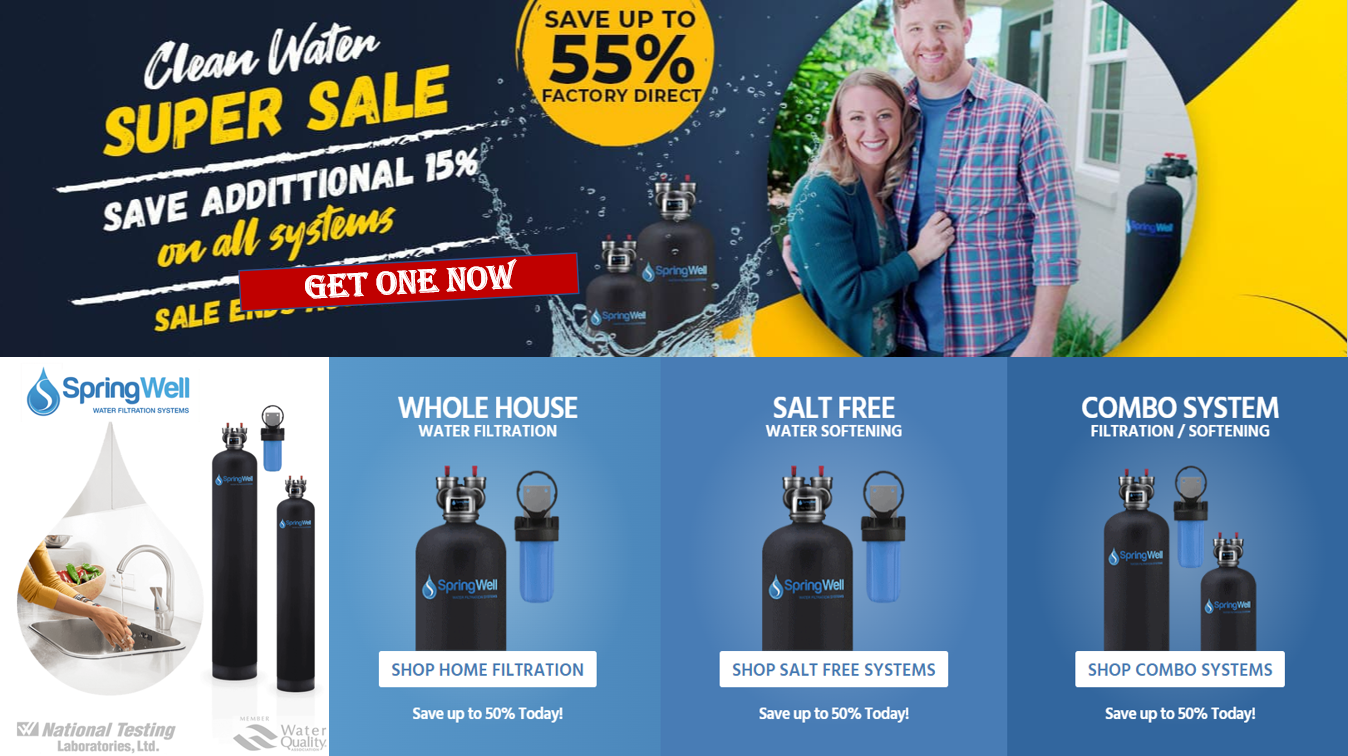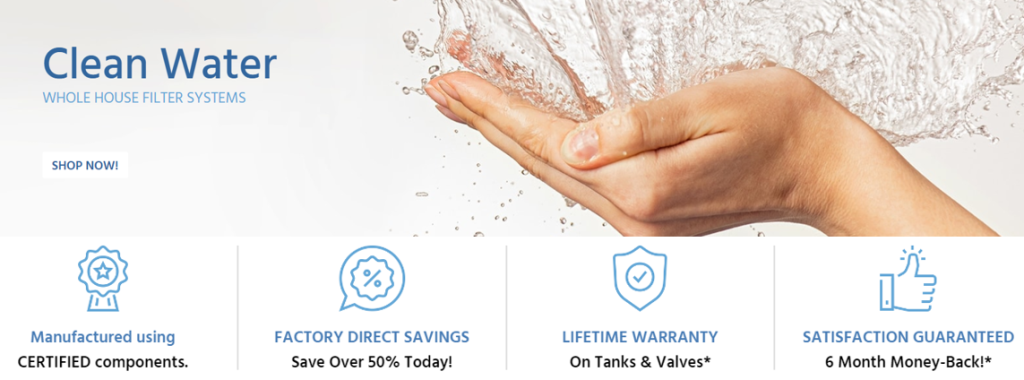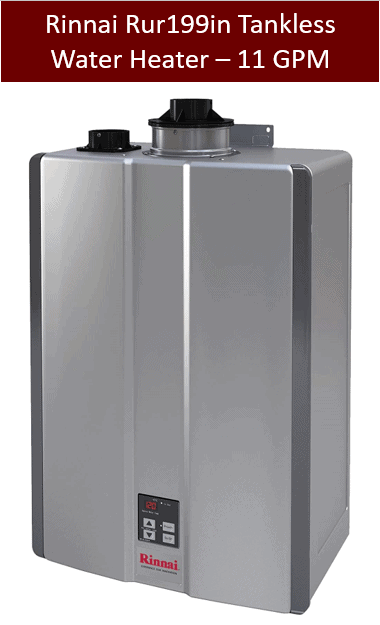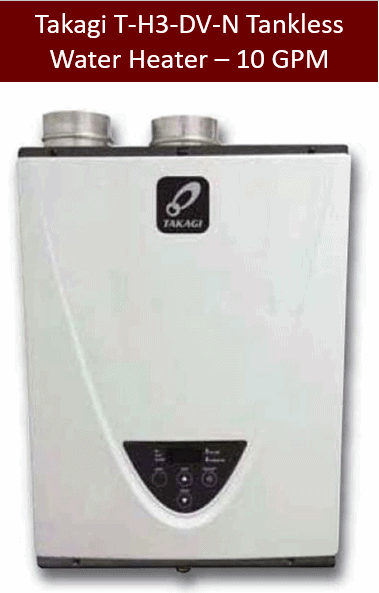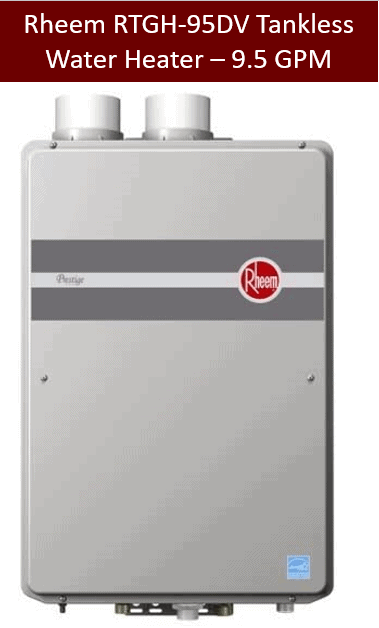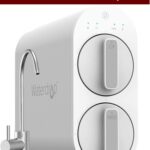Condensing tankless water heaters has been gaining popularity recently and for good reasons. They offer superior energy efficiency than any other water heaters. Due to this reason, they are certified as residential energy star certified home appliances. Meaning you are entitled to get a tax credit from the federal government if you buy a condensing water heater. Moreover, condensing gas water heaters have a faster hot-water supply rate, require less maintenance, environmentally friendly, and can easily last more than a decade. Check Out, our chosen 5 best condensing tankless water heater if you are interested in buying one.
5 Best Condensing Tankless Water Heaters
[amalinkspro_table id=”706″ aff-id=”home0446-20″ new-window=”on” nofollow=”on” addtocart=”off” /]
1) Rinnai Ru160in (9 GPM) Natural Gas Tankless Water Heater – Overall Best & Our First Choice
- Ru160in is an “Energy Star” & “Ultra Low-Nox” certified water heater.
- It is a recirculation capable unit made for indoors.
- It is a natural gas-powered water heater capable of supplying up to 9 gallons (34.07 liters) of water per minute.
- It can be run either by natural gas or propane and available both for indoor, outdoor installation.
- It is a 95% energy efficient machine. Energy Factor rating 0.95 and Uniform Energy factor rating 0.93.
- Fuel Consumption: 15,000 BTU(minimum) — 160,000 BTU(maximum) per hour.
- It has Wi-Fi, a remote monitoring system, freeze protection, a leek direction sensor, and automatic frost protection.
- This water heater is mobile home certified and can be installed in high altitudes up to 10,000 ft (3.05 kilometers) as well.
Rinnai Ru160in, in our opinion, the best condensing tankless water heater in the market. This condensing water heater maintains a perfect balance between price, power, and efficiency. Detailed Rinnai Ru160in Reviews is here.
Flexible Options: Ru160in is designed to operate in an indoor location and runs on natural gas. But if that is inconvenient for you, you can choose the outdoor variant as well. The outdoor variant is called Ru160en, ‘e’ tor external. Both the indoor and outdoor can be run either by natural gas or propane.
It can be mounted on any wall, even on your attic. It weighs around 65lb (29.48 kg) and makes 47 DB noise during operation.
Install a Home Water Filter & Get "Unlimited Safe Drinking Water" For Decades
Get Upto 55% Discount With a Lifetime Warranty & 6-Months Money Back Guarantee Free Shipping
SpringWell Water Filtration Systems: 100% American-Made & NSF Certified Water Filters and Water Softeners
Water Supply & Energy-Efficiency: The most important aspect of any water heater is its hot-water supplying rate and energy efficiency. It can provide gallons of hot water per minute. 9 GPM is enough to handle 2-5 fixtures at once.
The energy-efficiency of this machine is 95%. Meaning if you put 1 dollar in it, it will give you 95 cents of hot water. It scored 0.95 on the energy factor scale and 0.93 on the uniform energy factor scale.
Fuel consumption: To feed this you will need a 1/2-inch gas line in your home. Its minimum gas consumption rate is 15,000 BTU/h and the maximum gas consumption rate 160,000 BTU/h. The gas line should have 3.5in w.c — 10.5in w.c gas supply pressure for it to run properly.
Recirculation Capability: It is a recirculation capable water heater. Although it doesn’t have a pre-installed recirculation pump, it is compatible with third-party recirculation pumps. So if needed, installing a recirculation pump will be hassle-free.
Wi-Fi & Remote Monitoring System: Ru160in includes Wi-Fi and a remote monitoring system. After Amazon Alexa integration if you can control it with voice commands. Rinnai mobile app lets you monitor, manage, and run diagnostics on your heater from anywhere in the world.
Sensors and Safety Devices: Ru160in includes a direct electronic ignition system, water flow sensors, electronic water control, and bypass control. For all these electrical sensors it needs 52 w of electricity. It includes several safety devices such as Flame Failure — Flame Rod, Boiling Protection, Combustion Fan RPM Check, Over Current — Glass Fuse, Remaining Flame (OHS), and Automatic Frost Protection.
Energy Star & Ultra-Low Nox Certification: For its impressive thermal efficiency and environment-friendly operation, it is an ‘Energy Star’ and ‘Ultra-Low NOx’ certified product. You will get up to 300 bucks tax credit if you buy this heater.
Mobile Home Certificate: Ru160in is a mobile home certified water heater. So, it can legally be installed in mobile homes, trailers, off-grid houses. It won’t mess with the insurance policy you might have for your house. Also, this water heater has a high altitude operation certificate. It can operate even at 10,200 ft (3.11 kilometers).
Warranty: Provided warranty covers the heat exchangers: 15 years or 12,000 operation hours, (whichever occurs first), All Other Parts and Components: 5 Years, Reasonable Labor: 1 Year.
[i2pc][i2pros] Best overall value for your money.
Superior energy-efficiency.
Premium features like Wi-Fi, Amazon Alexa integration.
Reliable safety devices.
Certification for “Mobile Home’ installation.[/i2pros][i2cons]None.[/i2cons][/i2pc]
2) Rinnai Rur199in (11 GPM) Tankless Water Heater For Large House
- Rur199in is an “Energy Star” & “Ultra-Low NOx” certified gas water heater.
- It is a recirculation capable water that comes with a pre-installed recirculation pump.
- It is a natural gas-powered water heater capable of supplying up to 11 gallons (41.64 liters) of warm water per minute.
- It can be run either by natural gas or propane and available both for indoor, outdoor installation.
- It’s a 96% energy efficient machine. Energy Factor rating 0.96 and Uniform Energy factor rating 0.93
- Fuel Consumption: 15,000 BTU(minimum) — 199,000 BTU(maximum) per hour.
- It has Wi-Fi, a remote monitoring system, freeze protection, a leek direction sensor, and automatic frost protection.
- This water heater is mobile home certified and can operate in high altitudes (up to 10,000 ft (3.05 kilometers).) as well.
Rur199in is the most powerful and the most premium water heater you can buy right now. You can say it is the big brother of Ru160in. If are not afraid to upset your wallet then it is the best condensing tankless water heater for you. Detailed Rinnai Rur199in Reviews is here.
Flexible Options: just like Ru160in, Rur199in is also designed to operate in an indoor location and runs on natural gas. It is also available outdoors and can be run by propane gas.
This monstrous water heater weighs around 73lb (33.11 kg). So, you are going to need a solid wall and some strong brackets to install it in your house.
Water Supply & Energy-Efficiency: It can provide 11 gallons (41.64 liters) of water per minute. No matter where you live or how cold the weather is, RUR199in can meet your water demand instantly. With an 11 GPM water flow rate, it can manage up to 6 fixtures.
The energy-efficiency Rur199in is 96%. Meaning if you put 1 dollar in it, it will give you 96 cents of hot water. It beats its predecessor Ru160in not only in water supply rate but also in energy-efficiency as well. It scored 0.96 on the energy factor scale and 0.93 on the uniform energy factor scale.
Fuel Consumption: To feed this monster you are going to need a 1/2 inch gas line in your home. Its minimum gas consumption rate is 15,000 BTU/h and the maximum gas consumption rate 199,000 BTU/h. It is the most powerful residential water heater you can buy.
Make sure you have adequate gas supply pressure in your house. Otherwise, it will stress the machine and it’s expected lifespan will reduce. If you don’t have compatible gas lines it will be better for you to buy the propane variant, Rur199ip.
Recirculation Capability: Rur199in is a recirculation capable water heater with a built-in recirculation pump. It has the latest ThermaCric-360 recirculation technology.
Wi-Fi & Remote Monitoring System: Just like Ru160in, Rur199in includes Wi-Fi and a remote monitoring system. It is Amazon Alexa compatible. Rinnai mobile app lets you monitor, manage, and run diagnostics on it on the go.
Sensors and Safety Devices: Rur199in has a direct electrical ignition system, water flow sensors, electronic water control, and bypass control. To run these electrical sensors it needs 84 w of electricity. It includes several safety devices such as Flame Failure — Flame Rod, Boiling Protection, Combustion Fan RPM Check, Over Current — Glass Fuse, Remaining Flame (OHS), and automatic Frost Protection.
Energy Star & Ultra-Low Nox Certification: For its impressive energy efficiency and low gas emission, it is also an ‘Energy Star’ and ‘Ultra-Low Nox’ certified product. You will get up to 300 bucks tax rebate if you buy this heater.
Mobile Home Certificate: Rur199in is a mobile home certified water heater. We don’t really think anyone will install this big of a heater in mobile homes. But it’s good to know you can if you want.
Warranty: Provided warranty with Rur199in covers the heat exchangers: 15 years or 12,000 operation hours( whichever occurs first), All Other Parts and Components: 5 Years, Reasonable Labor: 1 Year
[i2pc][i2pros]The Highest water supply rate.
Superior energy-efficiency.
Premium features like Wi-Fi, Amazon Alexa integration.
Reliable safety devices.
Certification for “Mobile Home’ installation.[/i2pros][i2cons]High upfront cost.[/i2cons][/i2pc]
3) Takagi T-H3-DV-N (10 GPM) Residential & Commercial Tankless Water Heater
- Takagi T-h3-DV-N is an “Energy Star” & “Ultra Low-Nox” certified gas water heater.
- This residential water heater can be used with storage tanks, recirculation systems & radiant floor systems, etc.
- It is a natural gas-powered water heater capable of supplying up to 10 gallons (37.85 liters) of hot water per minute.
- It’s a 94% energy efficient machine. Uniform Energy factor rating 0.94
- Fuel Consumption: 19,500 BTU(minimum) — 160,000 BTU(maximum) per hour.
- It has several safety features that include freeze, overheat, surge protection, and a self-diagnostic system.
- It is certified for high altitudes, up to 10,100 ft (3.08 kilometers), operation.
The third water heater that we recommend for you is the Takagi T-H3-DV-N. It is a really powerful and well-built gas water heater from Takagi. It is designed to provide instant hot water to your domestic water systems. You can use it with storage tanks, hydronic heating systems, and radiant floor systems. It can be used both for residential and commercial purposes.
Flexible Options: Just like Rinnai, Takagi also makes 4 variants of their water heaters. Indoor-natural gas, Indoor-propane, Outdoor- Natural gas, Outdoor-Propane. This one (T-H3-DV-N) is made for indoor usage only. It is powered by natural gas, uses direct venting for exhaust gas, and weighs 59lb (26.76 kg).
Water Supply & Energy-Efficiency: T-H3-DV-N can provide a maximum of 10 GPM water flow rate. Takagi claims it can handle 4 showers in warmer climates and 3 showers in icy climates.
Takagi T-H3-DV-N is a 95% energy-efficient water heater. It scored 0.95 on the energy factor scale and 0.93 on the uniform energy factor scale. The secret of its impressive efficiency is its 2 heat exchangers. The primary heat exchanger of this heater is made of commercial-grade copper. Copper is 25 times better at thermal conductivity than stain steel. The secondary heat exchanger is made of 316L stainless steel to achieve better corrosion resistance.
Fuel consumption: This water heater ¾ inch gas line compatible and needs gas supply pressure between 4 in w.c-10in w.c. Its fuel consumption rate ranges from 15,000 BTU/h — 199,000 BTU/h.
Recirculation Capability: T-H3-DV-N have recirculation capability and doesn’t come with a pre-installed recirculation pump.
Remote Control System: Takagi provides a remote to control the heater. For commercial purposes, you can connect multiple T-H3 to meet larger hot-water demands. Using the multi-link system you can connect as much as 20 T-H3-DV-Ns.
Sensors and Safety Devices: Takagi T-H3-DV-N includes an integrated temperature controller, Air-fuel ratio sensor, Exhaust & water temperature safety control, overheat cut-off fuse, and freeze protection system. It has an advanced diagnostics system for you to simplify troubleshooting.
NSF, Energy Star & Ultra-Low Nox Certification: Takagi T-H3-DV-N is a lead-free water heater. Due to this reason, it has achieved NSF certification. And its impressive energy efficiency and environment-friendly operation, it is also got ‘Energy Star’ and ‘Ultra-Low Nox’ certifications.
Warranty: For Residential usage: 15-year limited warranty for the heat exchangers, 5 yrs limited warranty for the parts.
For Commercial usage: 5-year limited warranty for the heat exchangers, 5 yrs limited warranty for the parts
[i2pc][i2pros]Can be used both for residential and commercial purposes.
Energy saver.
Impressive water flow rate.
Reliable safety devices.
NSF certificates along with energy star & ultra-low NOx certificate.[/i2pros][i2cons]None.[/i2cons][/i2pc]
4) Noritz NRC66DVNG (6.6 GPM) Tankless Water Heater For Tiny House
- Noritz NDC66DVNG is an “NSF”, “Energy Star” & “Ultra Low-Nox” certified condensing instant water heater.
- It is a natural gas-powered water heater capable of supplying up to 6.6 gallons (24.98 liters) of hot water per minute.
- It can run either by using natural gas or propane.
- It is an 89% energy efficient machine. Uniform Energy factor rating 0.89.
- Fuel Consumption: 15,000 BTU(minimum) — 120,000 BTU(maximum) per hour.
- It has a built-in display monitor, freeze protection, overheat protection, and a lightning protection device.
The next item we have for you is a budget-friendly hot water heater from Noritz. Noritz NRC66DVNG can be the best condensing tankless water heater for you if you have a small to mid-sized family.
Flexible Options: Noritz NRC66DVNG is an indoor unit and can be run either by natural gas or propane.it is a relatively lightweight wall-mounted model. For those who are looking for an outdoor unit, Noritz made NRC66OD (outdoor model).
Water Supply & Energy-Efficiency: NRC66DVNG can provide a maximum of 6.6 GPM water flow rate. It is designed specifically for small & mid-sized families. The water flow rate is sufficient to handle no more than 2 shower heads at once.
NRC66DVNG is an 89% energy-efficient water heater. It scored 0.89 on the energy factor scale. We know it’s not as energy efficient as the above-mentioned water heaters. But when your water requirement is only 6-6.5 GPM, a few percent low energy efficiency won’t make a difference in your monthly utility costs.
Fuel consumption: Since it is a budget-friendly machine, it;’s fuel consumption rate is also economical. The fuel consumption rate ranges from 15,000 BTU/h — 129,000 BTU/h.
Recirculation Capability: NRC66DVNG doesn’t have recirculation capability.
Sensors and safety devices: NRC66DVNG is made with extremely durable polyester coated steel. It has a direct electronic incognito system, temperature controls, and a built-in display window. Safety devices include flame Sensor, Overheat Prevention Device, Lightning Protection Device, Freeze Protection, Condensate Overfill, Fan Rotation Detector, etc.
NSF, Energy Star & Low Nox Certification: Even with 89% energy efficiency, NRC66DVNG has managed to get Energy Star, NSF, and Low Nox certificate.
Warranty: With NRC66DVNG Noritz provides a 12-Year limited heat exchanger warranty for standard residential use, a5-Year Limited Parts Warranty, 1-Year Reasonable Labor Warranty
[i2pc][i2pros]Budget-friendly & cost effective option.
Economical fuel consumption rate.
Moderate energy-efficiency.
Reliable safety features.
NSF certificates along with energy star & ultra-low NOx certificate.[/i2pros][i2cons]No recirculation capability.
Low water supply.[/i2cons][/i2pc]
5) Rheem RTGH-95DVLN (9.5 GPM) Indoor Tankless Gas Water Heater
- Rheem RTGH-95DVLN is an “NSF”, “Energy Star” & “Ultra Low-Nox” certified tankless water heater.
- It is a recirculation capable water heater made for indoors.
- It is a natural gas-powered water heater capable of supplying up to 9.5 gallons (35.96 l) of hot water per minute.
- It is a 93% energy efficient machine. Uniform Energy factor rating 0.93.
- Fuel Consumption: 11,000 BTU(minimum) — 199,000 BTU(maximum) per hour.
- It has smart home features like Wi-Fi, a remote monitoring system, freeze protection, a leek direction sensor, and automatic frost protection.
Rheem RTGH-95DVLN is a very popular gas water heater. It is the latest edition of the Rheem prestige high-efficiency water heater series.
Flexible Options: RTGH-95DVLN is made for indoors and its counterpart RTGH-95XLN is made for outdoors. Both the water heater runs by natural gas.
Water Flow Rate & Energy-Efficiency: The maximum water supply rate of RTGH-95DVLN is 9.5 gallons (35.96 l) per minute. It can easily handle 3-4 fixtures in a warm climate and 1-2 fixtures in an icy climate.
Energy Consumption: The minimum energy consumption of this heater is 11,000 BTU per hour and the maximum fuel consumption is 199,000 BTU per hour.
Recirculation Capability: It is a recirculation-capable water heater but doesn’t come with a pre-installed recirculation pump. But you don’t have to worry because it is compatible with third-party recirculation pumps.
Smart Home Features: RTGH-95DVLN has some pretty exciting smart home features like Water leak detection alert and system shut off. Gas and water usage notifications, maintenance reminders can be seen through the Rheem mobile app. It can be easily integrated with smart home systems.
Sensors and Safety Devices: Rheem RTGH-95DVLN has a digital self-diagnostic system, remote control system, leak detection cable, overheat detector, etc.
Energy Star & Ultra-Low Nox Certification: For low gas emission it is certified as an Ultra-Low NOx heater and energy savings it has got energy star certificate.
Warranty: With Rheem Rtgh-95DLN, you get a 12-Year warranty for the heat exchanger, a 5-year warranty for the parts, and a 1-year warranty for the labor
Best Condensing Tankless Water Heater: Buying Guide
1) What size tankless water heater do you need?
When you are trying to buy a water heater the first thing you have to figure out “what size tankless water heater do you need?”
Let’s say you have a family of 4. You have a nice house that includes 1 tub, 2 shower heads, 1 kitchen sink, 1 dishwasher, and 1 washing machine, etc. Now, you need to calculate home many gallons of hot water you need at peak hours.
Peak hours like in the morning, when everyone in the family needs hot water at the same time. You need water for the shower. Your wife needs hot water in the Kitchen and your daughter also needs hot water because she is getting ready for college.
So, in total, you need 6-6.5 (2 GPM + 1.5 GPM + 2 GPM) gallons of water in the morning. Once you and your daughter leave for the office and college respectively, the hot water requirements drop. So, any water heater that can provide 6 or 6+ gallons of water per minute is right for your family.
We know every family is different and their water requirement is also different. So, we have listed some home appliances that use water and their water flow rate. Use the chart to calculate your hot water requirements at the peak hour.
| Fixture | GPM Rate |
|---|---|
| Shower | 2.0 – 3.0 GPM |
| Faucet (kitchen, bathroom) | 1.0 – 2.0 GPM |
| Dishwasher | 1.5 – 2.0 GPM |
| Washing Machine | 2.0-2.5 GOm |
2) Real water supply rate
Now you have to understand that the theoretical water supply rate and realistic water supply rate are two different things. Most brands brag about their water heater by stating their theoretical maximum water flow rate. For example, The maximum water supply rate of Rur199in is 11 gallons (41.64 liters) per minute. But in reality, you will get 10 gallons (37.85 liters) of hot water per minute at best. Let us explain why?
The water supply rate heavily depends on the temperature of your inlet water. The colder your inlet water is the lesser the water flow you will get, and vice versa.
Let’s assume you live in the northern part of the country, maybe in Minnesota or in North Dakota. The groundwater temperature of those areas is around 42 °F. Now, we are going to calculate Delta T.
The formula of Delta T = Your Desired water temperature — Your inlet water temperature.
If your desired water temperature for bathing is 100F, the value of Delta T will be 58 (100F minus 42F equal to 58). According to the water flow curve, you will get a maximum of 6.5 GPM water flow rate with Rur199in in Minnesota.
But the situation will change if you move to the southern part (Texas, Louisiana, Mississippi) of the country where groundwater temperature is around 70° F. In Texas, the value of Delta T will be 30 (100F minus 70F equal to 30). So there you will get 10 gallons (37.85 liters) of hot water with Rur199in.
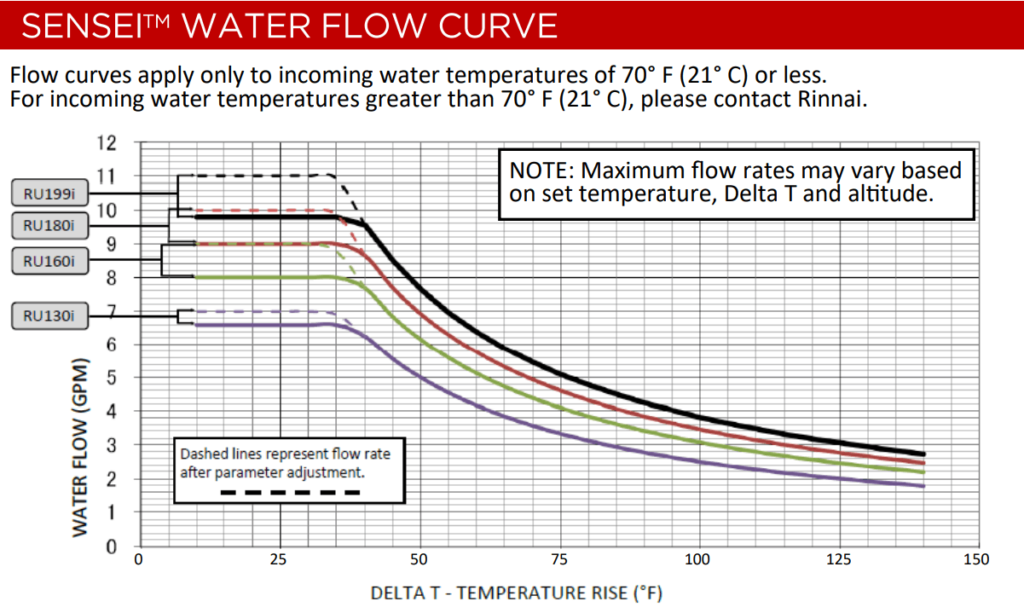
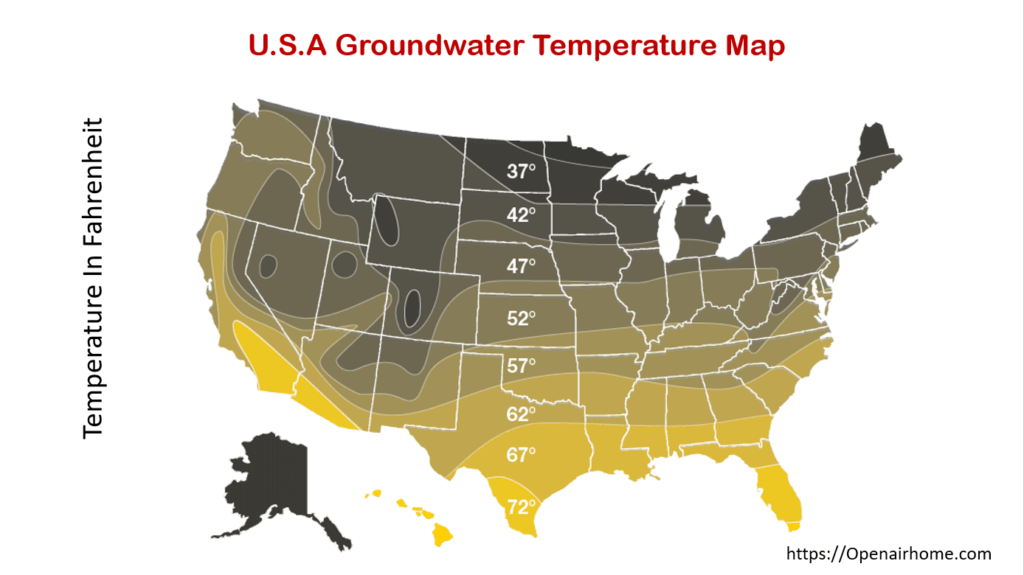
We have prepared a table that tells you the actual water flow rate of the condensing water heaters we have recommended earlier. Just find out the groundwater temperature of the area and then, subtract it from your desired water temperature. Once you get the Delta T value, you can easily figure out the GPM rate from the table. Place a comment in the “Comment-box” if you face any kind of confusion.
| Delta T=30 | Delta T=40 | Delta T=50 | Delta T=60 | Amazon | |
|---|---|---|---|---|---|
| Rinnai Ru160in | 8.0 GPM | 7.8 GPM | 6.0 GPM | 5.0 GPM | Check Price |
| Rinnai Rur199in | 10 GPM | 9.8 GPM | 8.0 GPM | 6.5 GPM | Check Price |
| Takagi T-H3-DV-NG | 8.5 GPM | 8.0 GPM | 7.0 GPM | 6.0 GPM | Check Price |
| Noritz NRC66DVNG | 6.6 GPM | 5.8 GPM | 4.6 GPM | 3.8 GPM | Check Price |
| Rheem RTGH-95DVLN | 9.5 GPM | 9.0 GPM | 7.5 GPM | 6.5 GPM | Check Price |
Based on your location if the value of Delta T= 50 and your needed water flow rate is 6.0 gallons (22.71 liters) per minute, then every water heater on the list can fulfill your requirements except Noritz NRC66DVNG. For your family, Noritz NRC66DVNG will be considered as an unpowered water heater.
3) Condensing Vs non-condensing tankless water heater
Every natural gas/ propane-fueled water heater can be divided into 2 categories:
1) Non Condensing water heater
2) Condensing water heater.
Based on their water heating mechanism, energy-efficiency, price, and maintenance cost they are way different from one another. Let us tell you both of these water heaters work, and then we will explain how they differ from each other.
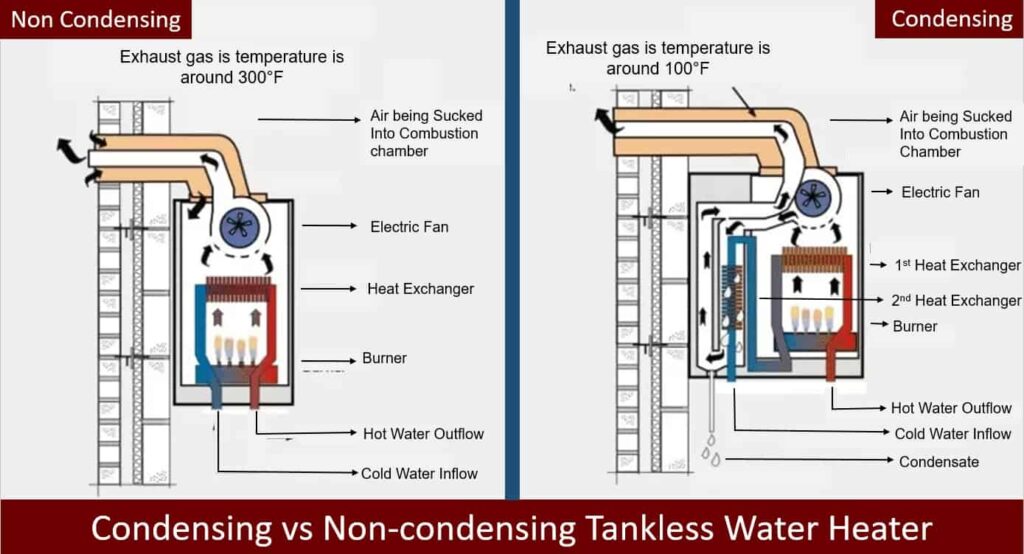
How non-condensing tankless water heaters work: The heating mechanism of a non-condensing gas water heater is pretty basic. Usually, a non-condensing unit includes 2 water lines (incoming and outgoing) one burner, one heat-exchanger, 2 vents, and one exhaust fan.
When hot water is needed, cold water gets into the machine through the incoming pipe. At the same time, an electronic ignition system activates the burner. The gas burner heats the heat-exchanger. When cold water passes through the heat exchanger it gets hot and comes out of the machine through the outgoing pipe.
During the process, the burner produces CO2, NO2, and other hazardous gases. The electric fan pushes out those gas through the exhaust vent.
How condensing tankless water heaters work: The heating mechanism of condensing units is not as simple as that of a non-condensing unit. Condensing units include 2 water lines, 2 heat exchangers, one burner, one neutralizer, 2 vents, one condensation line, and one exhaust fan.
When hot water is needed, cold water gets into the machine. Immediately the burner starts producing heat + hot gas by burning fuel. In a condensing water heater, cold water passes through 2 heat exchangers.
First step: Cold-water passes through the 1st heat exchanger. The 1st heat exchanger collects heat, not from the gas burner but the hot gas (already produced by the burner). It slightly warms up the cold water, maybe by 8-9 degrees Fahrenheit.
second step: In this step, Lukewarm water passes through the 2nd heat exchanger. The second heat exchanger collects heat directly from the gas burner and transfers it to the water. When the water temperature finally gets hot enough to meet your desired temperature, it gets out of the machine to the shower.
When the 1st heat exchanger sucks energy from hot gases, it automatically turns into a liquid called condensate. Condensate is a highly acidic liquid that is harmful to furniture, the human body, and the environment. So, a pre-installed neutralizer neutralizes the acidity of the condensate before pushing it out through the condensation line. The remaining exhaust gases in the machine, if any, get out through the exhaust vent.
Difference between condensing and non-condensing tankless water heaters
- Energy Efficiency: As you have already known, non-condensing water heaters let a good amount of hot gas escape without utilizing them. It increases energy wastage which in turn reduces energy efficiency. Usually, non-condensing units have an energy efficiency rating of around 80% — 82%.
But condensing units can get up to 92%-96% efficient. A condensing unit uses multiple heat exchangers to collect energy even from the exhaust gases. This ingenious idea reduces energy wastage at every step of the water process. This is the main reason behind their impressive energy efficiency.
- Maintenance Cost: Every water heater, whether it is condensing or non-condensing, produces hot gas (CO2, NO2) and steam as by-products.
From non-condensing units, those unprocessed hazardous gases and steam escape from the exhaust pipe. Usually, the temperature of those exhaust gases is around 300° F, and they are highly corrosive (PH 5.7). Only steel (grade-3) made venting pipes can withstand that temperature, and they are not cheap. They cast around 80-90 dollars a pop. Moreover, you will have to change it periodically. Because over time, the corrosive substance of those gases eats away metal venting pipe.
But inside a condensing water heater, those hot exhaust gases lose their temperature to the heat exchange and a neutralizer neutralizes their acidity. So, you can use any plastic (PVC) venting pipes with condensing units. PVC made venting pipes cost about 20-23 bucks. Since those venting pipes are made of plastic, they are very easy to install and repair.
- Price: Manufacturing a non-condensing water heater is easy. They require a simple design, fewer parts, less manpower, and cheap to produce. Every water heater brand makes non-condensing heaters. So, The price of non-condensing units ranges from 550-1200 bucks.
But Manufacturing a tankless heater that can achieve 90%-95% energy efficiency, energy star certificate, Ultra-Low Nox certificate is not an easy task. Condensing water heaters are way more complex to design and require technologically advanced factories to manufacture. Only the top water heater brands like Rinnai, Rheem, Takagi make condensing units. So, the price of condensing units starts at 1000-bucks and gets as high as 2500-bucks.
4) Natural gas vs propane: which one should you choose
The decision depends on fuel availability. If you have a compatible gas line in your home, you should choose the natural gas variant. Otherwise, you have no option but to choose the propane variant.
One more thing we would like to mention here, a powerful water heater that has a 199,000 BTU/h rating burns a lot of fuel. So, if you buy a propane-fueled powerful water heater, you may have to spend a considerable amount of time refueling it over and over again.
5) Recirculation capability and Recirculation pump:
A recirculation-capable water heater with an integrated recirculation pump reduces water wastage and lag time.
When you turn on your tap, you have to wait 30-40 seconds for the not water to come out. We call it lag time, the time required for the not water to reach your faucet from the water.
In those 30-40 seconds, you waste a lot of water. An average American family wastes around 11,000 gallons (41,639.53 l) of water annually only because they don’t have a recirculation-capable water heater.
Recirculation-capable water heaters push cold water from your water line back to the water storage tank. Thus, it reduces water wastage and lowers utility costs.
6) Condensing tankless water heater installation cost
Installation cost is one more thing that has to be factored in before buying a tankless water heater. Total installation cost includes :
- Electrical wiring cost: All water heaters, whether it is gas-fueled or propane-fueled, need electricity. So, you will need to install electrical circuits and required wires for the water heater. Depending on the water heater, you are looking at a wiring cost of 120-150 bucks.
- Gas line Upgrading cost: Not everyone will need gas line up-gradation. But if you don’t have a compatible gas line in your house, you will have no other choice but to upgrade it. Gas line up-gradation cast depends on various factors like gas pipe price, labor cost, new gas line register cost, etc. The total cost can go as high as 500-600 bucks.
- Labor Cost: A condensing water heater is a delicate machine and you will need professionals to install it in your house. Professionals charge 40-60 bucks for an hour. Installing a water heater usually takes 5-6 hours. So, you are looking at a total of 250-270 dollars for the labor cost.
In total, the installation cost can well around 750-900. Since the cost depends on various factors, it would be wise for you to contact a plumbing contractor to find out the exact installation cost for your house.
7) Condensing tankless water heater maintenance
Since 95% of the water in the U.S.A is hard, sooner or later you will see limescale buildup in your water heater. Limescale is that hard chalky white substance usually seen around water faucets. It reduces the energy efficiency and longevity
So, you will have to flush/ descale your water heater regularly. Depending on the hardness level of water in your area, it is recommended to flush a water heater every 6 months.
Advantages of condensing tankless water heater
The advantages of condensing water heaters are stupendous. The first and foremost advantage, known to everyone is energy efficiency. But that’s only the tip of the iceberg. We have listed all the major benefits that come with a condensing water heater below:
- Superior Energy-efficiency: For a long time water heaters remained infamous for their energy efficiency. Their monthly utility bill was overwhelming. But all of That changed with the introduction of condensing water heaters. Modern condensing water heaters can be up to 95%-96% energy efficient. If you switch to a condensing water heater from a conventional water heater, you can lower your utility bill by up to 30%-40%.
- Federal tax credit & ‘Energy Star’ Certificate: As you already know the US government is promoting energy-efficient home appliances among its citizens. The Energy Star program established by the Environment Protection Agency in 1992, is a part of that promotion campaign. Under the program, all condensing water heaters that are more than 90% energy efficient are certified as Energy Star residential home appliances. If you buy an energy star certified product, you can get a tax credit from the federal government. The Amount can get up to 300-400 bucks depending on the product specifics.
- Eco-friendly operation & ‘Ultra-low Nox’ Certificate: Since condensing water heaters are extremely energy efficient, they release very low amounts of Nitrogen oxides to the environment. Due to low gas emission, they are certified as “Ultra-Low Nox” certified products by the same Environment protection Agency.
Under the south coast air quality management regulation. All the water heaters on the south coast have to be ultra-low NOx certified. The plus point of having a condensing water heater is that you will be able to use it in every state of the country. This benefit you won’t get with other non-condensing on tank-style water heaters.
Most water has a lifespan of 12-15 years. So, if you live on the south coast/ plan to move to the south coast in the next few years, you better buy a condensing water heater.
Frequently Asked Questions
- How long does a tankless water heater last?
With proper maintenance, tankless water heaters can last for over 20 years. Although most water heater brands provide a warranty for 12-15 years at most.
- Does a gas tankless water heater use electricity?
Yes, gas-powered tankless water heaters use electricity. A modern condensing tankless water heater needs electricity for the electronic ignition system. Moreover, it requires electricity for various sensors like the temperate controller, Wi-Fi, remote controller, display monitor, leak detection sensor etc
- Do tankless water heaters need to be flushed?
Yes, tankless water heaters need to be flushed regularly. Depending on the hardness of inlet water, it is recommended that you flush your water heater every 6 months. Regular flushing prevents limescale build-up and thus increases the lifespan of your water heater.
- Can a tankless water heater be installed in the attic?
Yes, you can install your water heater in your attic.
- Can a tankless water heater be installed outside?
Yes, there are water heaters that are specifically designed to be installed outside. Almost every brand makes two variants of a particular water heater. One for the and one for the outdoors.
- Can tankless water heaters run on propane?
Yes. Almost every water heater that is designed for outdoor installation runs on propane.
- Does a tankless water heater qualify for a tax credit?
Only Energy Star-certified water heaters are qualified for a tax credit.
- Can a tankless water heater replace my boiler?
Yes.
Best Water Heater for Radiant Floor Heat in 2021
Full Review: Most Powerful Condensing Tankless Water Heater Rinnai Rur199in Reviews in 2021
Full Review: Most efficient Condensing Tankless Water Heater Rinnai Ru160in Reviews in 2021
Full Review: Reliable Non-Condensing Tankless Water Heater Rinnai Rl94in Review in 2021
Full Review: “Value For Money” Non-Condensing Tankless Water Heater Rinnai V65in Reviews in 2021
